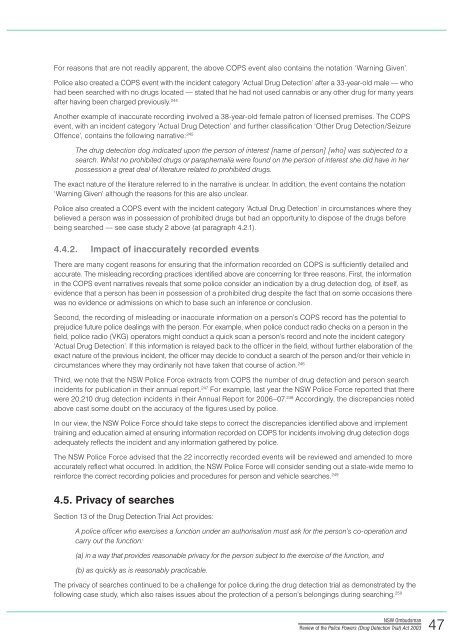Review of the Police Powers (Drug Detection Trial) Act 2003 - NSW ...
Review of the Police Powers (Drug Detection Trial) Act 2003 - NSW ...
Review of the Police Powers (Drug Detection Trial) Act 2003 - NSW ...
Create successful ePaper yourself
Turn your PDF publications into a flip-book with our unique Google optimized e-Paper software.
For reasons that are not readily apparent, <strong>the</strong> above COPS event also contains <strong>the</strong> notation ‘Warning Given’.<br />
<strong>Police</strong> also created a COPS event with <strong>the</strong> incident category ‘<strong>Act</strong>ual <strong>Drug</strong> <strong>Detection</strong>’ after a 33-year-old male — who<br />
had been searched with no drugs located — stated that he had not used cannabis or any o<strong>the</strong>r drug for many years<br />
after having been charged previously. 244<br />
Ano<strong>the</strong>r example <strong>of</strong> inaccurate recording involved a 38-year-old female patron <strong>of</strong> licensed premises. The COPS<br />
event, with an incident category ‘<strong>Act</strong>ual <strong>Drug</strong> <strong>Detection</strong>’ and fur<strong>the</strong>r classification ‘O<strong>the</strong>r <strong>Drug</strong> <strong>Detection</strong>/Seizure<br />
Offence’, contains <strong>the</strong> following narrative: 245<br />
The drug detection dog indicated upon <strong>the</strong> person <strong>of</strong> interest [name <strong>of</strong> person] [who] was subjected to a<br />
search. Whilst no prohibited drugs or paraphernalia were found on <strong>the</strong> person <strong>of</strong> interest she did have in her<br />
possession a great deal <strong>of</strong> literature related to prohibited drugs.<br />
The exact nature <strong>of</strong> <strong>the</strong> literature referred to in <strong>the</strong> narrative is unclear. In addition, <strong>the</strong> event contains <strong>the</strong> notation<br />
‘Warning Given’ although <strong>the</strong> reasons for this are also unclear.<br />
<strong>Police</strong> also created a COPS event with <strong>the</strong> incident category ‘<strong>Act</strong>ual <strong>Drug</strong> <strong>Detection</strong>’ in circumstances where <strong>the</strong>y<br />
believed a person was in possession <strong>of</strong> prohibited drugs but had an opportunity to dispose <strong>of</strong> <strong>the</strong> drugs before<br />
being searched — see case study 2 above (at paragraph 4.2.1).<br />
4.4.2. Impact <strong>of</strong> inaccurately recorded events<br />
There are many cogent reasons for ensuring that <strong>the</strong> information recorded on COPS is sufficiently detailed and<br />
accurate. The misleading recording practices identified above are concerning for three reasons. First, <strong>the</strong> information<br />
in <strong>the</strong> COPS event narratives reveals that some police consider an indication by a drug detection dog, <strong>of</strong> itself, as<br />
evidence that a person has been in possession <strong>of</strong> a prohibited drug despite <strong>the</strong> fact that on some occasions <strong>the</strong>re<br />
was no evidence or admissions on which to base such an inference or conclusion.<br />
Second, <strong>the</strong> recording <strong>of</strong> misleading or inaccurate information on a person’s COPS record has <strong>the</strong> potential to<br />
prejudice future police dealings with <strong>the</strong> person. For example, when police conduct radio checks on a person in <strong>the</strong><br />
field, police radio (VKG) operators might conduct a quick scan a person’s record and note <strong>the</strong> incident category<br />
‘<strong>Act</strong>ual <strong>Drug</strong> <strong>Detection</strong>’. If this information is relayed back to <strong>the</strong> <strong>of</strong>ficer in <strong>the</strong> field, without fur<strong>the</strong>r elaboration <strong>of</strong> <strong>the</strong><br />
exact nature <strong>of</strong> <strong>the</strong> previous incident, <strong>the</strong> <strong>of</strong>ficer may decide to conduct a search <strong>of</strong> <strong>the</strong> person and/or <strong>the</strong>ir vehicle in<br />
circumstances where <strong>the</strong>y may ordinarily not have taken that course <strong>of</strong> action. 246<br />
Third, we note that <strong>the</strong> <strong>NSW</strong> <strong>Police</strong> Force extracts from COPS <strong>the</strong> number <strong>of</strong> drug detection and person search<br />
incidents for publication in <strong>the</strong>ir annual report. 247 For example, last year <strong>the</strong> <strong>NSW</strong> <strong>Police</strong> Force reported that <strong>the</strong>re<br />
were 20,210 drug detection incidents in <strong>the</strong>ir Annual Report for 2006–07. 248 Accordingly, <strong>the</strong> discrepancies noted<br />
above cast some doubt on <strong>the</strong> accuracy <strong>of</strong> <strong>the</strong> figures used by police.<br />
In our view, <strong>the</strong> <strong>NSW</strong> <strong>Police</strong> Force should take steps to correct <strong>the</strong> discrepancies identified above and implement<br />
training and education aimed at ensuring information recorded on COPS for incidents involving drug detection dogs<br />
adequately reflects <strong>the</strong> incident and any information ga<strong>the</strong>red by police.<br />
The <strong>NSW</strong> <strong>Police</strong> Force advised that <strong>the</strong> 22 incorrectly recorded events will be reviewed and amended to more<br />
accurately reflect what occurred. In addition, <strong>the</strong> <strong>NSW</strong> <strong>Police</strong> Force will consider sending out a state-wide memo to<br />
reinforce <strong>the</strong> correct recording policies and procedures for person and vehicle searches. 249<br />
4.5. Privacy <strong>of</strong> searches<br />
Section 13 <strong>of</strong> <strong>the</strong> <strong>Drug</strong> <strong>Detection</strong> <strong>Trial</strong> <strong>Act</strong> provides:<br />
A police <strong>of</strong>ficer who exercises a function under an authorisation must ask for <strong>the</strong> person’s co-operation and<br />
carry out <strong>the</strong> function:<br />
(a) in a way that provides reasonable privacy for <strong>the</strong> person subject to <strong>the</strong> exercise <strong>of</strong> <strong>the</strong> function, and<br />
(b) as quickly as is reasonably practicable.<br />
The privacy <strong>of</strong> searches continued to be a challenge for police during <strong>the</strong> drug detection trial as demonstrated by <strong>the</strong><br />
following case study, which also raises issues about <strong>the</strong> protection <strong>of</strong> a person’s belongings during searching. 250<br />
<strong>NSW</strong> Ombudsman<br />
<strong>Review</strong> <strong>of</strong> <strong>the</strong> <strong>Police</strong> <strong>Powers</strong> (<strong>Drug</strong> <strong>Detection</strong> <strong>Trial</strong>) <strong>Act</strong> <strong>2003</strong><br />
47

















